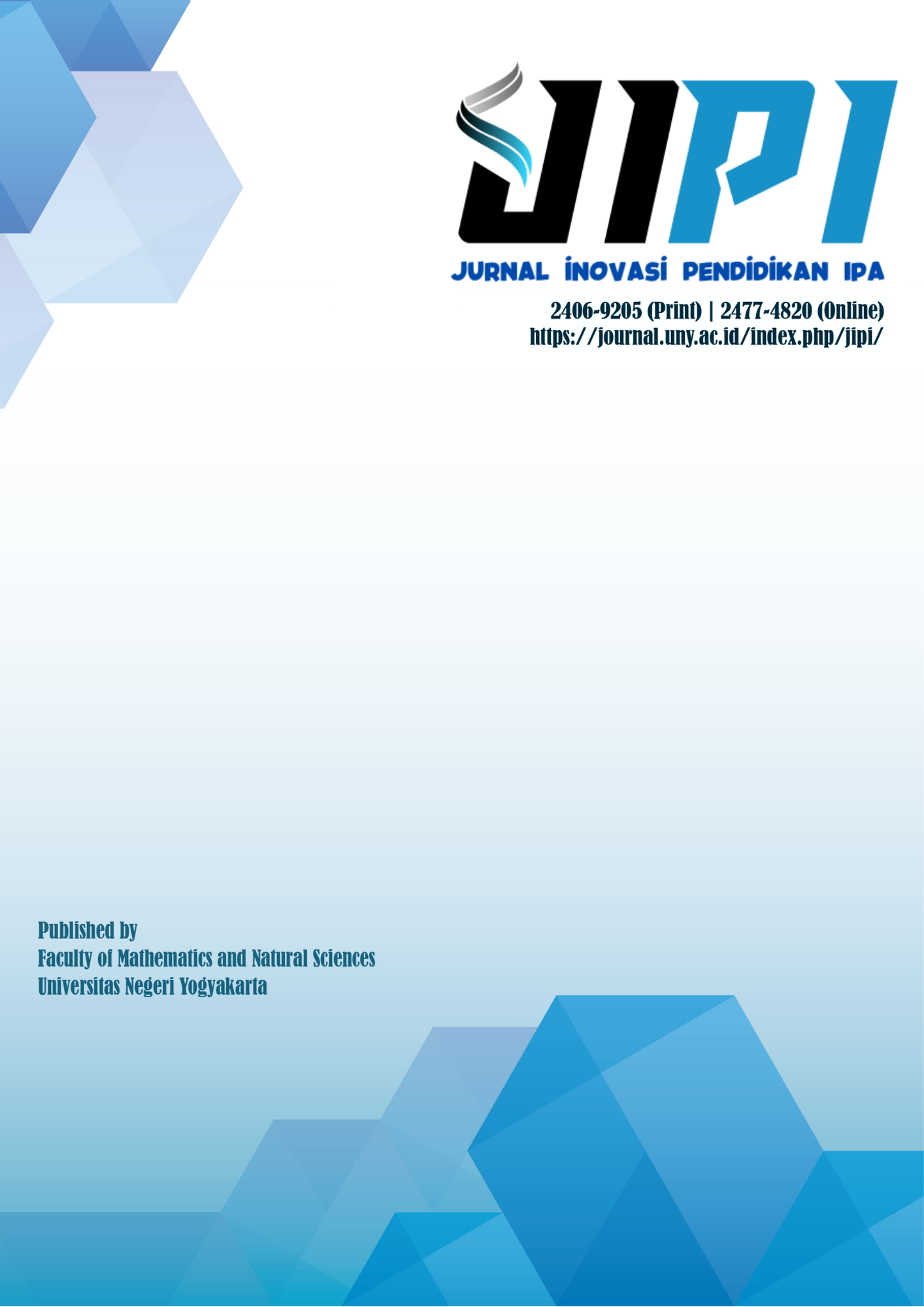STUDI KEMAMPUAN GURU KIMIA SMA LULUSAN UNY DALAM MENGEMBANGKAN SOAL UAS BERBASIS HOTS
DOI:
https://doi.org/10.21831/jipi.v1i1.4533Keywords:
chemistry teacher, higher order thinking skills, questionsAbstract
References
Aksela, M. (2005). Supporting meaningful chemistry learning and higher order thinking through computer assisted inquiry: A design research approach. academic Dissertation. Chemistry Education Center Department of Chemistry University of Helsinki Finland.
Aydin, N., Yilmaz, A. (2010). The effect of constructivist approach in chemistry education on students' higher order cognitive skills. Journal of Education, (39), 57-68.
Bagarukayo, E. (2012). The impact of learning driven constructs on the perceived higher ordercognitive skills improvement: Multimedia vs. text. International Journal of Education and Development using Information and Communication Technology, (8), pp.120-130.
Devi, P.K. (23 Januari 2012). Pengembangan soal "higher order thinking skill" dalam pembelajaran IPA SMP/MTs. Diakses 23 September 2013 dari www.p4tkipa.net/data-jurnal/HOTs. Poppy.pdf.
Gilligan, M.E. (2007). Traditional versus alternative assessments: which type do high school teachers perceive as most effective in the assessment of higherorder thinking skills?. A Dissertation.Presented to the Faculty of the Graduate School of Saint Louis University in Partial Fulfillment of the Requirements for the Degree of Doctor of Philosophy.ProQuest LLC.
Haladyna, T.M. (1997). Writing test items to evaluate higher order thinking skills. Bosotn: A Pearson Education Company.
Karamustafaoglu, S., et.al, (2003). Analysis of turkish high-school chemistry-examination questions according to blooms taxonomy.chemistry education. Research and Practice , (4), pp.25-30.
Kartini, T. (2011). Faktor-faktor yang mempengaruhi kompetensi profesional guru di SMK N 1 Losarang Kabupaten Indramayu. Tesis tidak diterbitkan, Universitas Indonesia, Jakarta.
Khan,W.B. & Inamullah, H.M. (2011). A Study of Lower-order and Higher-order Questions at Secondary Level. Canadian Center of Science and Education Asian Social Science,(7), 9.
King, F.J., Goodson, L.,& Rohani, F. (2013). Higher order thinking skills. Diakses tanggal 11 Juli 2013 dari http://www.cala.fsu.edu/files/higher_ord er_thinking_skillsPdf.
Lai, E.R. (2011). Critical thinking: A literature review. research report. Diakses 29 Agustus 2013 dari http://www.pearson assessments.com/hai/images/tmrs/critica l ThinkingReviewfinal.pdf.
Muaddab, H. (2011). Jaminan mutu dalam sertifikasi guru. Diakses 27 Juli 2013 http://Netsains.Net/2011/10/JaminanMutu-Dalam-Sertifikasi-Guru/.
Percoski, T.D. (2011). The use of higher order cognitive strategies to improve student understanding of high school chemistry concepts. Thesis of Master of Science Education. Montana State University Bozeman, Montana. Diakses 29 Agustus 2013 dari http://scholarworks.montana.edu/xmlui/ bitstream/handlen/1/2039/PercoskiT081 1.pdf? Sequence=1. Reeves, T.C. (2006). How do you know they are learning?: the importance of alignment in higher education. Int. J. Learning Technology, 2, (4):297.
Sahlberg, P. (2010). The secret to Finland's success:Educating teacher. Diakses 27 Juli 2013 dari www.edpolicy. stanford.edu.
Saptorini.(2010). Pengembangan model pembelajaran berbasis inkuiri sebagai upaya peningkatan kemampuan inkuiri guru kimia di Kabupaten Demak. Diakses 27 Juli 2013 dari http://journal.unnes.ac.id/nju/index.php/ rekayasa/article/download.
The Education For All Development Index. (2011). Education for all global monitoring reports. Diakses 2 Oktober 2013 dari www.unesco.org/new /fileadmin/gmr2011-efa-developmentindex.pdf.
Tikkanen, G., & Aksela, M. (2012). Analysis of Finnish chemistry Matriculation Examination questions according to Cognitive Complexity. Nordina Journal, (8), 258-268.
Wilson,V. (2000). Education forum on teaching thinking skills. edinburgh. report, the scottish council for research in education. Diakses 20 Agustus2013 dari http://www.sciesocialcareonline.org.uk/Repository /fulltext/educthinking.pdf.
Zohar, A., & Dori,Y.J. (2003). Higher order thinking skills and low-achieving students: Are they mutually exclusive?. The Journal of The Learning Sciences, (12), pp.145-181.
Yang, C. (2012). Applications of chemical learning evaluation based on Bloom's taxonomy of educational objectives. J. Chem. Eng. (1), p.495.
Downloads
Published
How to Cite
Issue
Section
Citation Check
License
The authors submitting a manuscript to this journal agree that, if accepted for publication, copyright publishing of the submission shall be assigned to Jurnal Inovasi Pendidikan IPA (JIPI). However, even though the journal asks for a copyright transfer, the authors retain (or are granted back) significant scholarly rights.
Jurnal Inovasi Pendidikan IPA by http://journal.uny.ac.id/index.php/jipi/index is licensed under a Creative Commons Attribution-ShareAlike 4.0 International License.










